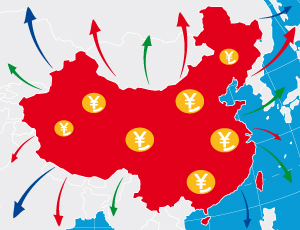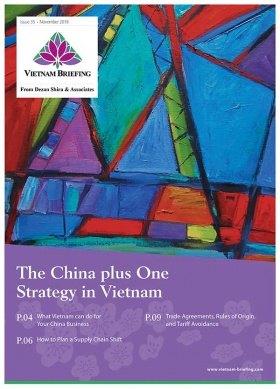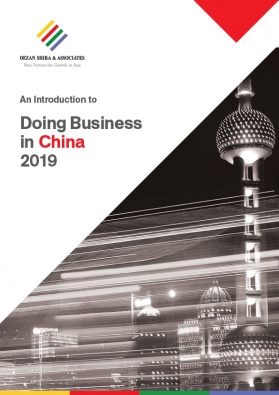The US-China Trade War and Declining Trade? We’ve Been Here Before.
Op/Ed by Chris Devonshire-Ellis
 The US-China trade war – on which negotiators have recently pushed back any hopes for a compromise to April at the earliest – has resulted in the World Bank forecasting that the global economy will shrink to 2.9 percent in 2019, from three percent in 2018. It cites the US-China trade issue as the main factor responsible. Given that the US and China contribute to over one-fifth of world trade, any developments in their relationship has an impact on global trade, thereby affecting other nations too.
The US-China trade war – on which negotiators have recently pushed back any hopes for a compromise to April at the earliest – has resulted in the World Bank forecasting that the global economy will shrink to 2.9 percent in 2019, from three percent in 2018. It cites the US-China trade issue as the main factor responsible. Given that the US and China contribute to over one-fifth of world trade, any developments in their relationship has an impact on global trade, thereby affecting other nations too.
There are grumbles in the United States about US manufacturing companies having to shift production out of China and elsewhere into Asia, with Vietnam being specifically mentioned. Yet this is nothing new. American beancounters have always tended to be on the ball. As regards Vietnam, Dezan Shira & Associates established offices there some twelve years ago, and the inaugural issue of our supporting Vietnam Briefing magazine was titled “Global Manufacturing is Moving to Vietnam“. That was published in April 2008. Moving production from China or elsewhere to Vietnam isn’t a recent trend. It’s been the norm for over a decade.
Concerning Dezan Shira’s American clients based in China, there hasn’t been a mass exit from China to Vietnam. Some may have established operations in Vietnam to shift part of their production there, but that is linked to both lower production costs (although these are rising) but also the growing consumer market in ASEAN, of which Vietnam is a member state. US manufacturers are staying in China because they also wish to maintain access to the Chinese market. It is only the small, export-to-US-only manufacturers that are suffering from having factories based only in China. And they’ve had ten years plus to adapt.
All that aside, in terms of US trade wars, we’ve been here before. The US-China spat replicates to a large degree the US-Japan trade dispute, which lasted until the early 1990’s. The two countries were locked in trade battles concerning Japan’s massive export surplus to the US, with Washington also accusing Japan of taking advantage of their fixed exchange rate with the US dollar. Does that sound familiar? So how did it end, and what happened next?
Eventually, Japan made concessions – although it took ten years – and abandoned the fixed exchange rate. This raised the value of the Japanese Yen, Japanese goods became uncompetitive, and Japanese exports to the US declined. Sounds pretty bad for Japan, right?
Japan’s economy was back then and still is export based, and the US was their single biggest market. To get away from the higher value of the Yen, Japanese companies shifted their factories to low cost ASEAN countries, and subsequently to China, when China liberalized its FDI policy back in the early 1990’s.
We can expect China, and foreign investors looking at the export market to do the same and relocate export-driven manufacturing investment overseas. It will help China counter-balance the impact of higher tariffs imposed by the US. That process has already begun; however, it is important to understand it is not inclusive. Companies wishing to sell to the Chinese market will largely remain in China, where a massive consumer population gives them every incentive to do so. Analysts complain and moan about “a China slowdown” but these are false prophets, GDP growth in China this year is expected to be about 6 percent. That compares positively with the EU at 1.5 percent, and the US at 2.3 percent. The message remains clear – if you want to improve your chances of making money in the US or EU, you can still go and set up in China and make more money there. As for the rest of developing Asia, 2019 GDP growth rates in India are set to be 7.3 percent, Vietnam 7 percent, Indonesia 6 percent, and the Philippines 8 percent. It’s a similar story across much of emerging Asia, from Cambodia to Sri Lanka and all the points in-between. Look again at the World Bank 2019 forecast for GDP growth – 2.9 percent, and look at China’s – 6 percent. It doesn’t look so bad in China, right?
What is happening then is nothing really to be concerned about; it is a natural shift, in part led by politics and policy, but one that can be relatively painlessly planned for by the astute foreign investor. There is precedent. The US owned, export driven manufacturers being squeezed by tightening margins in China really have only themselves to blame. Nothing lasts forever, and China was always, one way or another, going to become more expensive. As I pointed out, we started commenting on this trend 12 years ago, it is nothing new. Meanwhile, readership of our ASEAN Briefing website is going through the roof as investors want to understand what is going on in their respective legal, tax, and regulatory fields. There are alternatives to China, which is why our practice began investing in Southeast Asia well over a decade ago.
Dezan Shira & Associates assist foreign investors throughout Asia in legal, tax, and regulatory matters related to Asian cost comparisons, tax planning, relocating, corporate establishment and ongoing advisory, accounting, and HR and payroll services.
We maintain offices throughout China, India, ASEAN, and Vietnam. Please contact us at asia@dezshira.com or visit us at www.dezshira.com.
- Previous Article What Chongqing’s Declining Growth Rate Tells Us about China’s Slowdown
- Next Article Les entreprises américaines en Chine se développent malgré les tensions récentes : enquête AmCham 2019
























